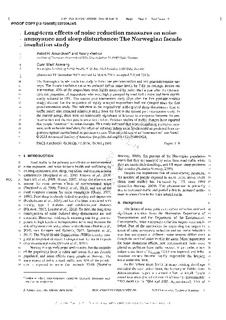Long-term effects of noise reduction measures on noise annoyance and sleep disturbance: The Norwegian facade insulation study
Journal article, Peer reviewed
Accepted version
Permanent lenke
http://hdl.handle.net/11250/2602743Utgivelsesdato
2013-06-05Metadata
Vis full innførselSamlinger
Originalversjon
Journal of the Acoustical Society of America. 2013, 133 (6), 3921-3928. 10.1121/1.4802824Sammendrag
The Norwegian facade insulation study includes one pre-intervention and two post-intervention surveys. The facade-insulating measures reduced indoor noise levels by 7 dB on average. Before the intervention, 43% of the respondents were highly annoyed by noise. Half a year after the intervention, the proportion of respondents who were highly annoyed by road traffic noise had been significantly reduced to 15%. The second post-intervention study (2 yr after the first post-intervention study) showed that the proportion of highly annoyed respondents had not changed since the first post-intervention study. The reduction in the respondents' self-reported sleep disturbances (due to traffic noise) also remained relatively stable from the first to the second post-intervention study. In the control group, there were no statistically significant differences in annoyance between the pre-intervention and the two post-intervention studies. Previous studies of traffic changes have reported that people “overreact” to noise changes. This study indicated that when considering a receiver measure, such as facade insulation, the effect of reducing indoor noise levels could be predicted from exposure-response curves based on previous studies. Thus no evidence of an “overreaction” was found.

